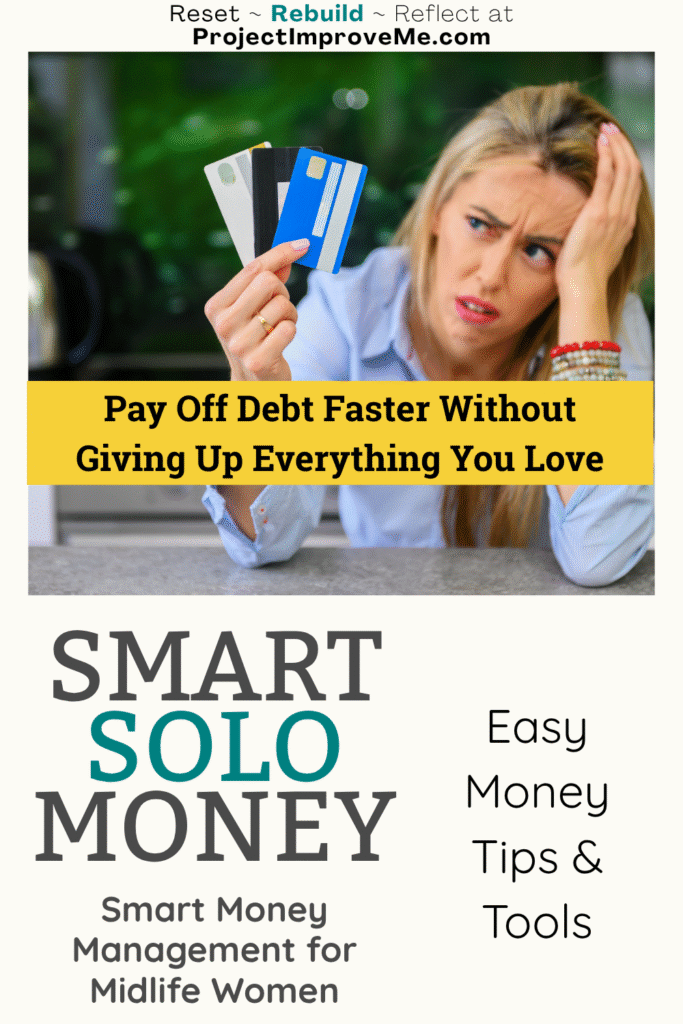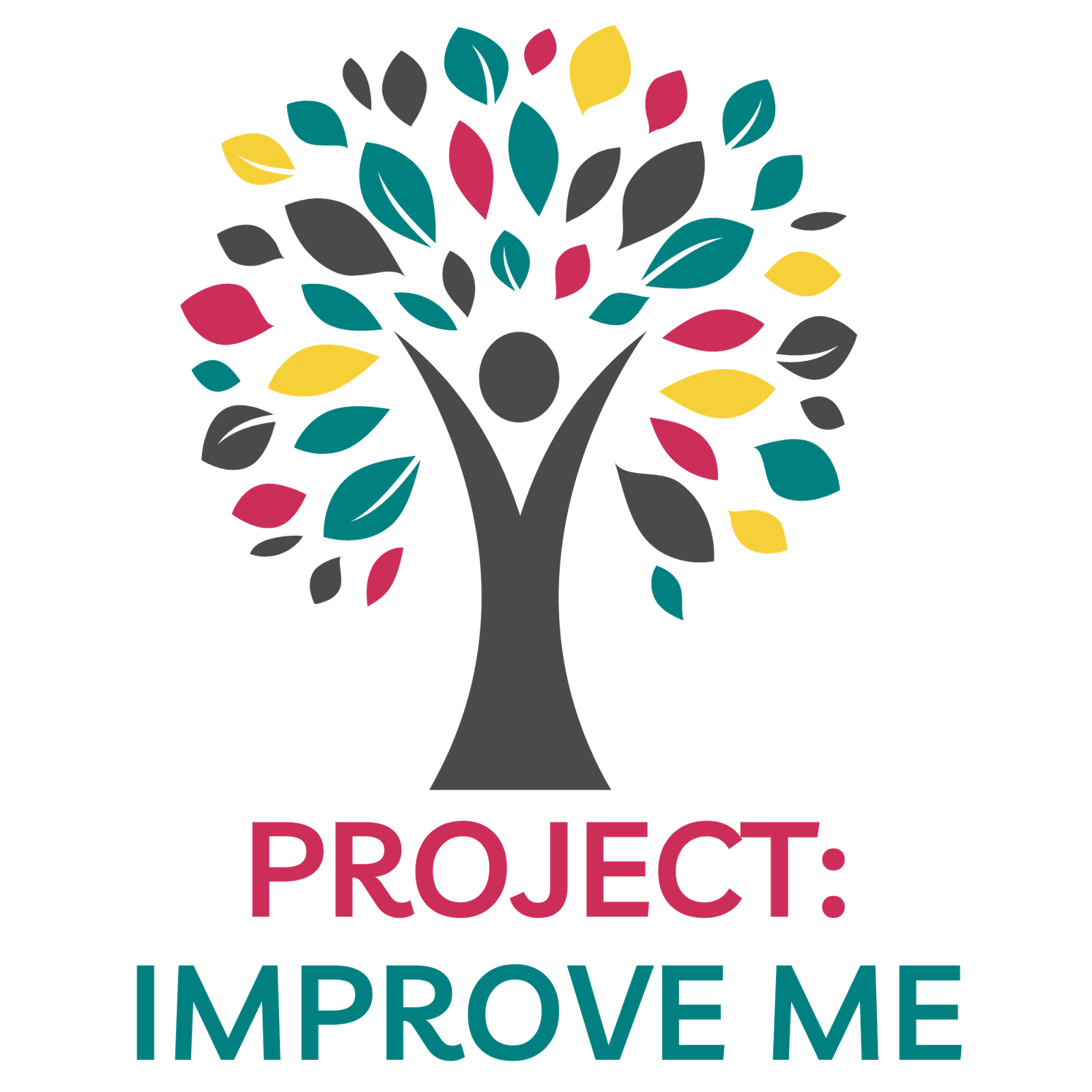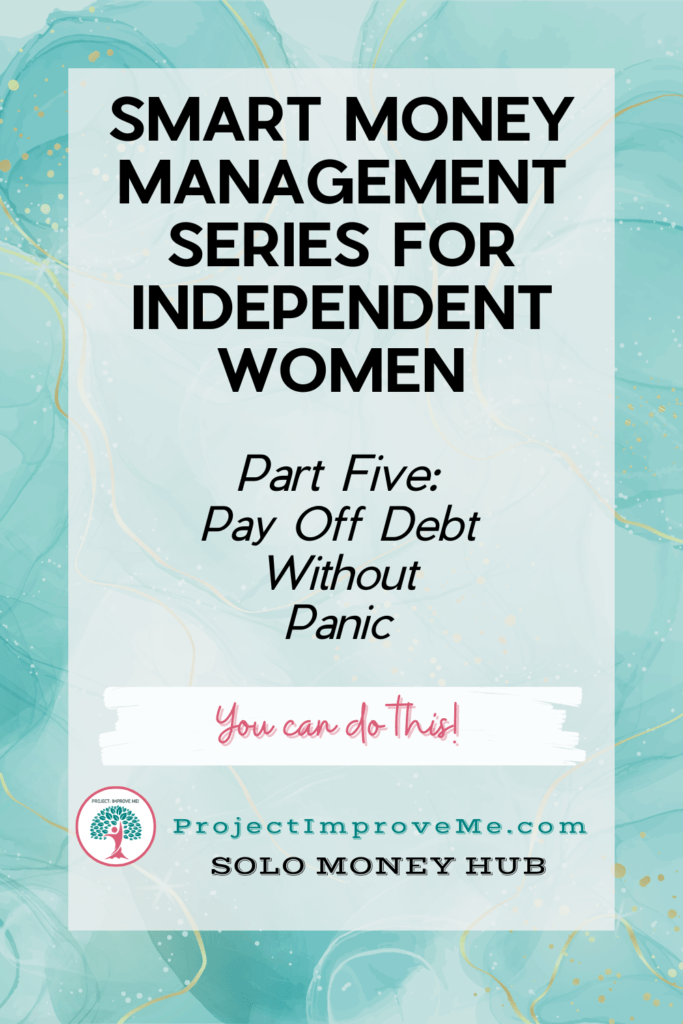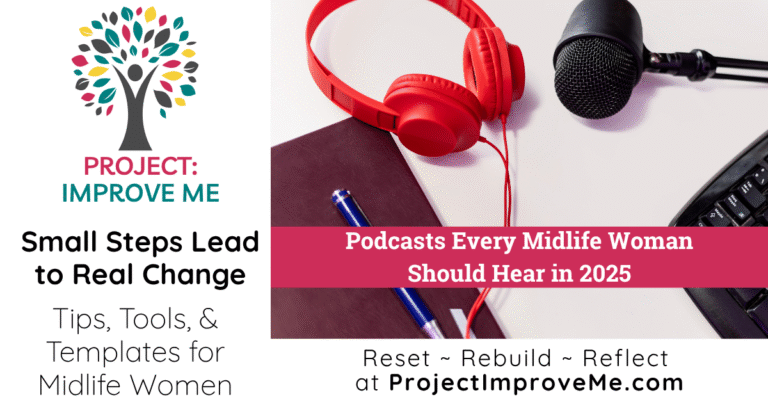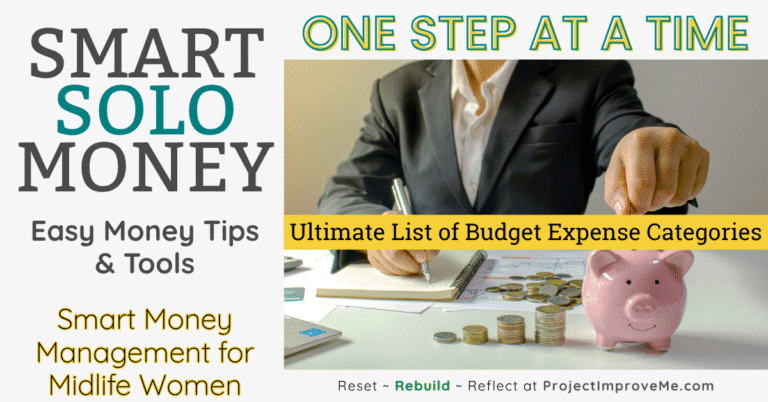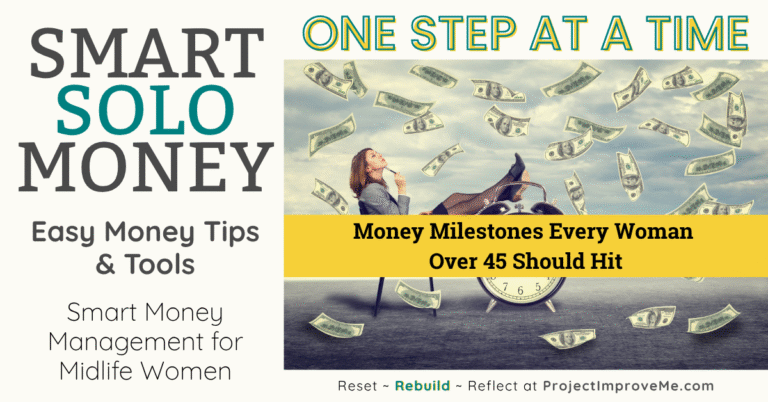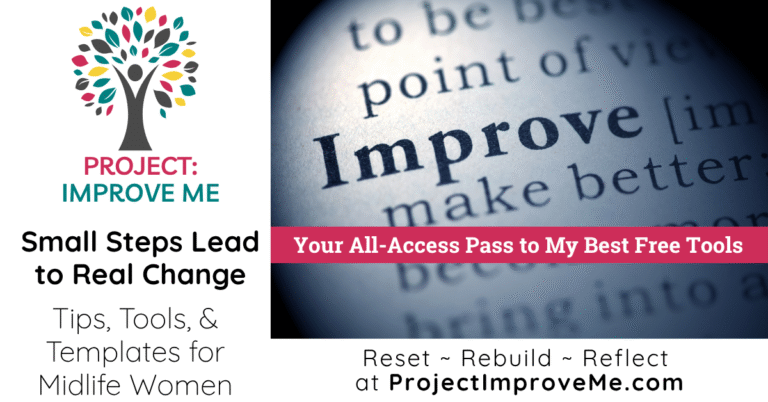Because staying in control feels better than staying in debt.
Why Debt Feels Different When You’re Solo
If you’re managing debt on a single income, it can feel like you’re carrying the weight of the world. No second paycheck to lean on, no one to tag in when things get tight—just you, juggling life and trying not to lose sleep over money.
Take a breath. You’re not alone, and this step is here to help you feel less overwhelmed and more in charge.
💬 Debt isn’t a personal failure. It’s a numbers game—with a dash of mindset.
And even small progress counts.
💡 This post is part of the Smart Money Management Series — your step-by-step guide to financial confidence for independent women. Visit the Solo Money Hub » to see all 6 parts and grab your free Starter Kit!
📊Reality Check: You’re Not the Only One
If you’ve ever felt like you’re the only one dealing with debt while everyone else is thriving—please hear this:
📌 About 80% of single women in their 40s and 50s carry some form of debt.
And many are figuring it out on their own, just like you.
You don’t have to pay it off perfectly. You just have to start.
🧍♀️Solo Tip: Your debt journey is uniquely yours. Don’t waste energy comparing it to anyone else’s.
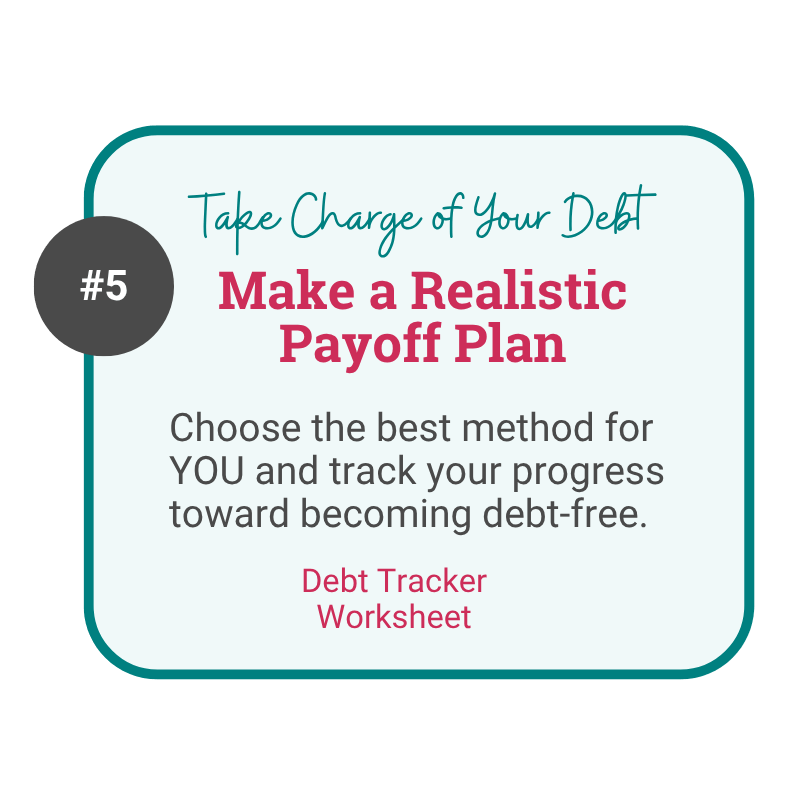
💥 What Makes Debt So Overwhelming?
Let’s be honest—debt isn’t just about the numbers.
It’s the emotional toll it takes that wears you down.
- 📉 You feel like you’re falling behind, even when you’re making payments.
- 📬 You get a knot in your stomach every time a bill shows up.
- 📊 You start doubting yourself, even though you’re doing your best.
And there’s more happening beneath the surface…
🧠 Common Debt Triggers You Might Not Notice
- You avoid checking your bank or credit card apps
- You say “yes” to things you can’t afford—to avoid guilt or awkwardness
- You feel panicked near the end of the month—even if everything’s paid
💬 If this sounds familiar, you’re not broken. You’re just ready for a better way.
🧭 Your Smart Solo Debt Strategy
Getting out of debt starts with clarity, not shame.
Here’s how to build a plan that works for your life—and your bandwidth:
- Face the full picture.
List every debt: amounts, due dates, interest rates, and minimums.
No shame—just data. - Pick your path.
Choose a method that feels doable (we’ll go over options below). - Make room in your budget.
Even $20/month toward your smallest debt makes a difference. - Track your progress visibly.
Seeing results = staying motivated.
💡 Small Moves That Add Up
- Round up every purchase and apply the spare change to debt (apps like Qapital or Chime’s Round-Up can automate this)
- Use “found money” like rebates, tax refunds, or birthday cash for extra payments
- Cancel one subscription and apply that $15/month to your smallest debt
📌 Little by little becomes a lot.
💡 Do Not Use Your Emergency Fund for Debt Repayment
Here’s something a lot of people don’t talk about:
Throwing every extra dollar at your debt might feel “responsible,”
but if you don’t have a safety net… you’re one emergency away from falling back into debt.
That’s why Step 4 came first.
Before you go hard on debt payoff, build a basic emergency fund—at least $1,000.
🚗 Car breakdown?
🐾 Pet emergency?
🦷 Surprise dental bill?
You’ll have cash to handle it—and won’t have to swipe a card.
🧍♀️Solo Tip:
Keep your emergency fund in a separate high-yield savings account.
Close enough to access in a real emergency, but far enough out of reach to resist dipping into it on a whim.
📌 Your emergency fund is not optional. It’s protection for Future You.
📈 Debt Payoff Boosts More Than Your Budget
As you pay down your balances, something powerful happens:
✅ Your credit score improves
✅ Your interest rates may drop
✅ You feel in control again
📉 Most women in their 40s and 50s don’t have perfect credit. That’s okay.
But progress now can open new doors later—especially if you ever need to refinance or apply solo.
🧍♀️ Solo Tip:
Pull your credit reports for free at AnnualCreditReport.com
🗓 Do it now, then again every 6 months to track your progress.

📊 Pick a Payoff Path That Works for You
Not sure where to start? Here are the two most popular methods:
🌱 Snowball Method
Pay off your smallest balance first.
→ Quick wins = motivation boost.
🔥 Avalanche Method
Pay off your highest-interest debt first.
→ Saves the most money long-term.
📌 Both work.
The right one is the one you’ll stick with.
🧍♀️Solo Tip:
If stress is high, go for the quick win.
It’s okay to choose the method that supports your energy—not just the math.
💳 Should You Consolidate Your Debt?
Juggling multiple payments with different due dates?
That’s not just frustrating — it’s mentally exhausting.
Debt consolidation can be a smart move if you’re looking to simplify.
It rolls multiple debts into one payment — ideally with a lower interest rate.
It might be a good fit if:
- You’re paying over 15% interest on cards or loans
- You have steady income but struggle to keep track of due dates
- Your credit score has improved since taking on the debts
But it’s not always the magic fix.
🧍♀️ Solo Tip:
Before you consolidate, get honest about what led to the debt.
A new loan won’t help if the habits stay the same.
Think of consolidation as a tool — not a solution by itself.
🧭 Feeling Stuck? Professional Help Is an Option
If the pressure of managing it all is just too much, asking for help is not failure.
It’s being wise with your energy.
🧰 One company I’ve heard positive things about is National Debt Relief.They’ve helped people I trust, and as of March 2025, they have a
⭐ 4.8-star Google rating with over 5,000 reviews.
But — do your own homework.
Read the fine print and make sure it’s a fit for your situation.
🧍♀️ Solo Tip:
If you’re unsure, I always recommend checking out NFCC.org first.
They’re a nonprofit and offer neutral, trustworthy support.
✨ It’s About More Than Numbers
Sometimes, debt comes with emotional baggage—especially after a major life change like divorce or caregiving.
You’re not just paying off credit cards.
You’re healing, growing, and rebuilding.
And that takes more than a spreadsheet.
If you need extra emotional support:
- Visit DivorceCare.org for healing after separation
- Look for local women’s groups for connection and encouragement
🧍♀️ I haven’t personally been through divorce, but many women in our community have—and I see how money and emotions often go hand in hand.
You don’t have to carry it all alone.
✅ Your Debt Reset Checklist
You don’t need to fix everything overnight.
Just start with one small move — the rest will follow.
- List all your debts (no shame, just facts)
- Pick a strategy that fits your energy and goals
- Protect your emergency fund like the lifeline it is
- Make one extra payment this month (even $10 counts)
- Track your wins so you stay motivated
💡 Tip: The Solo Money Companion Workbook is perfect if you want to map this all out with formulas done for you. It’s available in the Solo Money Shop.
💸 Tools to Help You Move Forward
📄 Debt Tracker Worksheet
📘 Intentional Spending Planner
📊 Solo Money Companion Workbook
Everything you need to start is included in the free Solo Money Starter Kit —
plus bonus tools inside the Freebie Vault.
👉Get the Starter Kit here – unlock the Freebie Vault with your name + email.
PIM Community Question
What’s the hardest part about tackling debt solo?
Drop a comment below or send me a message — I’d love to hear your story
And don’t forget —
👉 Next up in the Smart Money Series: Part 6 – Growing Wealth & Earning More
Project: Improve Me! – Home of the Second Chapter Solution Studio™
Custom tools for women simplifying life after 40.
More about me and my mission: 👉🏼 HERE

Hi! I’m Kari. I started Project: Improve Me in 2025, right after turning 50, because I wanted something more meaningful than just spreadsheets and journal entries. I’m a single grandma working in accounting, and I see so many women overwhelmed at this stage of life. That’s why I’m here — to help midlife women get their digital lives in order, stress less about money, and share their stories… even if no one’s asking for them. It’s not about fixing your whole life overnight, just making it a little easier one step at a time.
.
Pin This Post:
